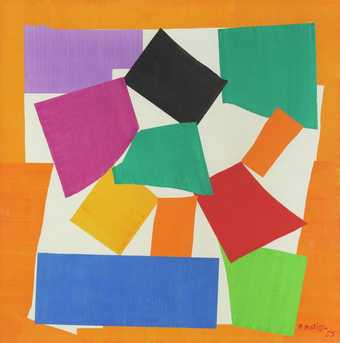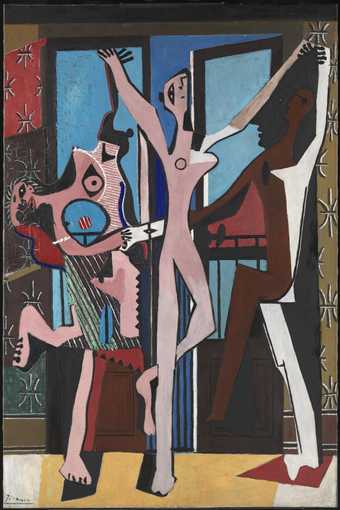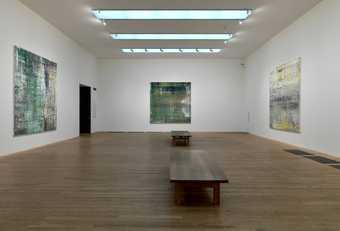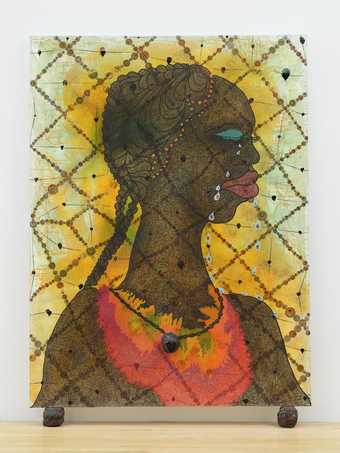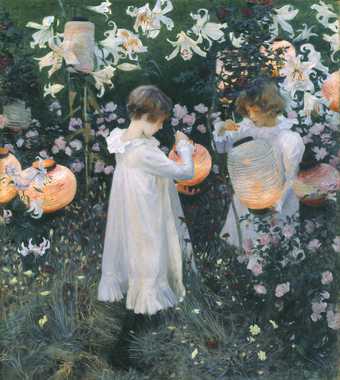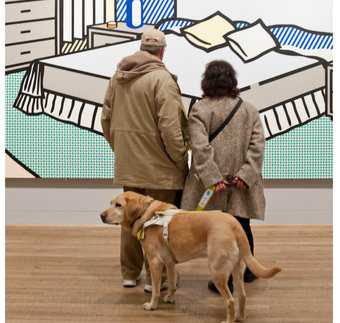This thickly-painted Picasso oil 7 feet high and 4 and a half wide in predominantly blue, pink and black interlocking jagged shapes is taken up by three contrasting naked figures holding hands in a frenzied dance. Behind, rectangles of vibrant blue indicate a pair of balconied floor to ceiling French windows with sky and maybe sea beyond. The positions of the dancers’ arms and legs tell us they’re dancing in a ring, but the image has little sense of depth.
Against a central vertical of dark blue sky where the windows have been pushed slightly open, a simple, elongated figure in pale pinks stands on one straight leg with the other bent up at the knee - simultaneously facing us and moving towards the right with jutting breast in profile - head back and arms flung up in a V of ecstasy or supplication.
On the left is another pink figure, also on one straight leg, moving in the same direction. But the other leg is kicked up behind, and the head is arched back at an almost impossible angle towards that heel. This figure is a complicated jumble of different shapes. The face, twisted to stare at us is like a wild mask or skull, with black almond-shaped eye-sockets and red gash mouth with sharp white fish-like teeth. A patch of green with parallel diagonal white lines and patches of other colour with black dogtooth surround may indicate a skirt. On this is a blue oval with vertical black line – like a hole through which the background blue and balcony are visible. At chest-level is a larger ‘hole’, an upside-down teardrop with a central red circle – like a breast. Above are two more breast-like shapes - following the line of the figure’s contorted body and left arm as it stretches up to join hands with one of the hands of the central figure. The top breast is a black rounded silhouette against the blue with big nipple like a doorknob, facing right. This woman’s other arm reaches behind the back of the central figure to link hands with the third figure – on the right side of the work.
This third dancer is moving in the opposite direction, right to left, and in contrast with the others is made up of three vertical angular stripe-like blocks in black, white and dark brown. With left arm vertical this dancer holds hands in the top right corner with the central figure, making a triangular space between the arms - painted black, like a pointed hat. In the centre of this is a small brown helmet shape in profile facing left. But the black triangle suggests a bigger head enclosing the first. At the top of the ‘hat’, either side of the point, black lines with rounded ends like violin pegs - where Picasso has indicated the spaces between the fingers of the two hands - suggest the bobbled or belled tassels of a pierrot or harlequin. And at the bottom left of the triangle is the silhouetted profile of a long-nosed face.
Picasso made this work in 1925 when he was married to Russian ballerina Olga Khoklova, a dancer with Diaghilev’s Ballets Russes. It’s thought to relate to a tragic episode in his life from twenty-five years earlier. We know he kept it for forty years – and the lumpy surface suggests repeated overpainting - evidence perhaps of the extent to which the episode continued to obsess him.
‘The Three Dancers’ started out as a relatively straightforward representation of a dance rehearsal. But X-rays have revealed that Picasso then made radical changes. While he was working on it he heard of the death of an old friend Ramon Pichot. Pichot and another artist, Carlos Casagemas, had accompanied Picasso on his first trip to Paris in 1900. In Paris, Casagemas had fallen in love with a woman called Germaine. But she rejected him, and in a fit of passion Casagemas took at shot at her before killing himself. Soon afterwards Germaine married Pichot. This painting seems to tell the story of that tragic love triangle. In a dance of love, sex and death the woman on the left is Germaine, arching her back to avoid the red spot – possibly the bullet; the central figure is the victim Casagemas, and the figure on the right is Pichot - linking hands behind Casagemas’ back with Germaine.
